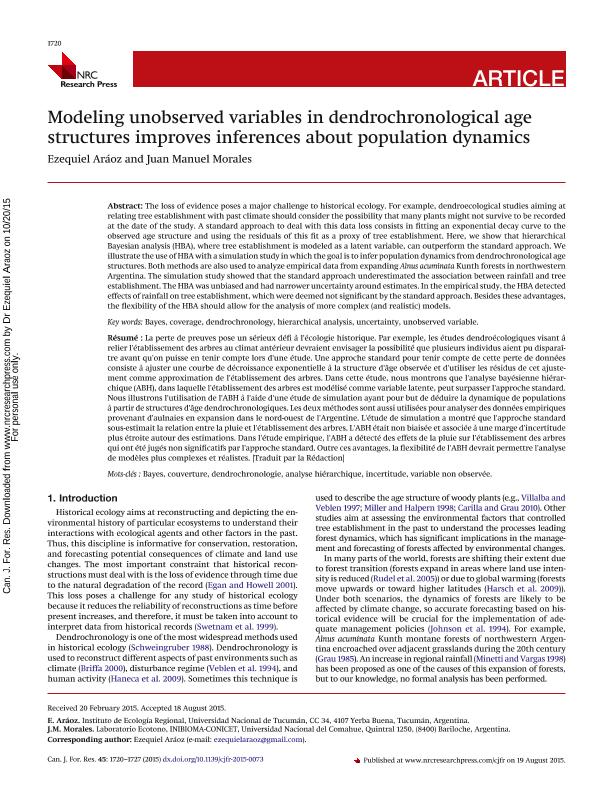Mostrar el registro sencillo del ítem
dc.contributor.author
Aráoz, Ezequiel

dc.contributor.author
Morales, Juan Manuel

dc.date.available
2017-01-19T19:18:45Z
dc.date.issued
2015-08
dc.identifier.citation
Aráoz, Ezequiel; Morales, Juan Manuel; Modeling unobserved variables in dendrochronological age structures improves inferences about population dynamics; Natl Research Council Canada-n R C Research Press; Canadian Journal Of Forest Research; 45; 12; 8-2015; 1720-1727
dc.identifier.issn
0045-5067
dc.identifier.uri
http://hdl.handle.net/11336/11646
dc.description.abstract
The loss of evidence poses a major challenge to historical ecology. For example, dendroecological studies aiming at relating tree establishment with past climate should consider the possibility that many plants might not survive to be recorded at the date of the study. A standard approach to deal with this data loss consists in fitting an exponential decay curve to the observed age structure and using the residuals of this fit as a proxy of tree establishment. Here, we show that hierarchical Bayesian analysis (HBA), where tree establishment is modeled as a latent variable, can outperform the standard approach. We illustrate the use of HBA with a simulation study in which the goal is to infer population dynamics from dendrochronological age structures. Both methods are also used to analyze empirical data from expanding Alnus acuminata Kunth forests in northwestern Argentina. The simulation study showed that the standard approach underestimated the association between rainfall and tree establishment. The HBA was unbiased and had narrower uncertainty around estimates. In the empirical study, the HBA detected effects of rainfall on tree establishment, which were deemed not significant by the standard approach. Besides these advantages, the flexibility of the HBA should allow for the analysis of more complex (and realistic) models.
dc.format
application/pdf
dc.language.iso
eng
dc.publisher
Natl Research Council Canada-n R C Research Press

dc.rights
info:eu-repo/semantics/openAccess
dc.rights.uri
https://creativecommons.org/licenses/by-nc-sa/2.5/ar/
dc.subject
Bayes
dc.subject
Coveraje
dc.subject
Dendrochronology
dc.subject
Hierarchical Analysis
dc.subject.classification
Ecología

dc.subject.classification
Ciencias Biológicas

dc.subject.classification
CIENCIAS NATURALES Y EXACTAS

dc.title
Modeling unobserved variables in dendrochronological age structures improves inferences about population dynamics
dc.type
info:eu-repo/semantics/article
dc.type
info:ar-repo/semantics/artículo
dc.type
info:eu-repo/semantics/publishedVersion
dc.date.updated
2016-12-12T14:23:14Z
dc.journal.volume
45
dc.journal.number
12
dc.journal.pagination
1720-1727
dc.journal.pais
Canadá

dc.journal.ciudad
Otawa
dc.description.fil
Fil: Aráoz, Ezequiel. Universidad Nacional de Tucumán. Facultad de Ciencias Naturales E Instituto Miguel Lillo. Instituto de Ecología Regional; Argentina
dc.description.fil
Fil: Morales, Juan Manuel. Universidad Nacional del Comahue. Centro Regional Universitario Bariloche. Laboratorio de Ecotono; Argentina. Consejo Nacional de Investigaciones Científicas y Técnicas. Centro Científico Tecnológico Patagonia Norte. Instituto de Investigación en Biodiversidad y Medioambiente; Argentina
dc.journal.title
Canadian Journal Of Forest Research

dc.relation.alternativeid
info:eu-repo/semantics/altIdentifier/url/http://www.nrcresearchpress.com/doi/abs/10.1139/cjfr-2015-0073#.WIEQWvnhCJA
dc.relation.alternativeid
info:eu-repo/semantics/altIdentifier/doi/http://dx.doi.org/10.1139/cjfr-2015-0073
Archivos asociados
